FEATURES|COLUMNS|Buddhist Art
Pema Namdol Thaye: A Maker of Mandalas
The Sanskrit word “mandala” literally means a sacred center (la) that has been set apart or adorned (mand). In theory, therefore, a mandala can take any form, but most mandala depictions are intricately painted geometric patterns intended to represent the floor plan of a palace with four main gates. Within the palace are central and outer halls surrounding a central deity, which is often encircled by lesser deities in a hierarchical arrangement. To Buddhists, particularly those from the Tibetan tradition or the esoteric schools in Japan, mandalas are among the most powerful tools used in visualization practice. By focusing on particular deities in their sacred abodes, practitioners strive to form a connection with these higher energies and awaken higher qualities in themselves, thus bringing them closer to spiritual enlightenment.
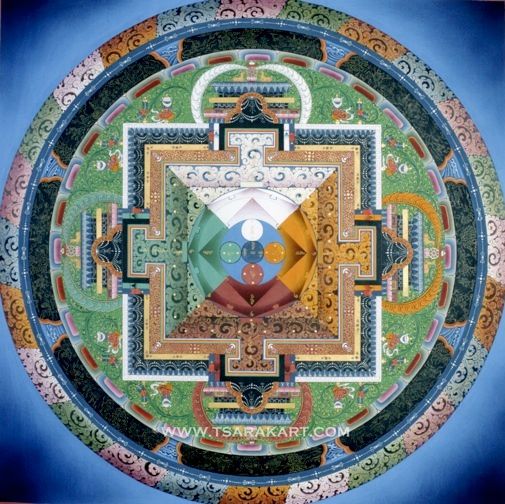
Painted Shi-tro Mandala (Mandala of the Peaceful and Wrathful Deities of the
One Hundred Buddha Families), by Pema Namdol Thaye. 2012, pigments and
gold on canvas. Image courtesy of the artist
US-based Tibetan artist Pema Namdol Thaye is one of the world’s foremost contemporary makers of mandalas. As a child growing up in Bhutan, Thaye displayed great artistic talent and spent years drawing characters and scenes from comic books. Because of his skill, at the age of 13 his uncle trained him in thangka painting, and after years of study he eventually mastered the geometry, symbolism, and iconography of this complex Tibetan artistic tradition. Now, from his home and studio just outside Los Angeles, Thaye employs traditional Tibetan techniques and mineral pigments to create intricately detailed paintings of Buddhist deities and their mandalas, which are mounted on silk and used by Buddhists all around the world in their personal practice. In February this year, the US-based publisher Shambhala released a limited-edition (108 copies) art book containing prints of Thaye’s finest paintings of mandalas and deities. The first advance copy of Celestial Portfolio was presented to His Holiness the Dalai Lama in Delhi in late 2014.
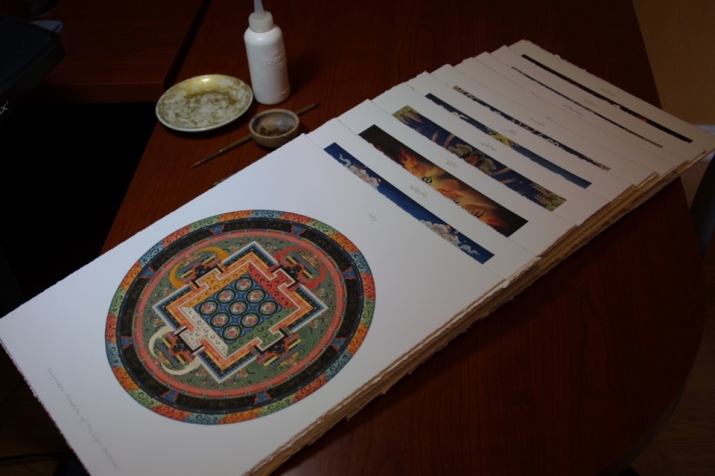 Pages from Celestial Portfolio, prints of art by Pema Namdol Thaye, published by Shambhala Publications, February 2015. Image courtesy of the artist
Pages from Celestial Portfolio, prints of art by Pema Namdol Thaye, published by Shambhala Publications, February 2015. Image courtesy of the artistAlthough painted mandalas are two-dimensional, the structure of a mandala is fundamentally architectural, and for special purposes, three-dimensional mandalas are created usually from painted and gilded wood. In 2000, Thaye completed a three-dimensional Shi-tro Mandala (Mandala of the Peaceful and Wrathful Deities of the One Hundred Buddha Families) for Ari Bhöd, a Tibetan Nyingma Buddhist community in California, as a tool for peace. A spectacular work measuring over 7 feet high and 20 feet in diameter built from painted wood and containing deities modeled from clay, the structure was shown at several museums in California and is now displayed at Ari Bhöd’s retreat center in Tehachapi, central California. Since then, Thaye’s three-dimensional mandalas have been exhibited in a number of American and European museums, including Tibet House, New York, the Victoria and Albert Museum, London, and the UCLA Hammer Museum, Los Angeles.
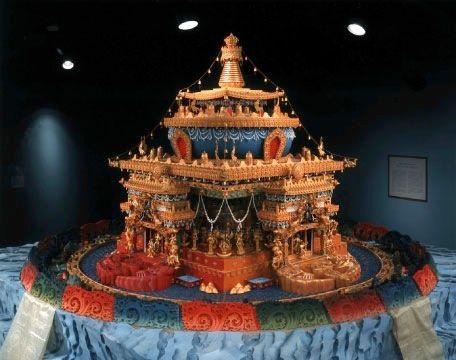
Three-dimensional Shi-tro Mandala, by Pema Namdol Thaye. 2000,
wood, clay, and pigments. Image courtesy of the artist and Ari Bhöd,
Tehachapi
Thaye’s renown has also attracted the attention of lamas in the East. In 2011, Rigzin Dorjee Rimpoche, the founder and head of the Nyingma Institute and the Nyingma Retreat Center in Sikkim, who was familiar with both Thaye’s paintings and the three-dimensional mandala he had created for Ari Bhöd, commissioned Thaye to design a Buddhist temple for Sikkim modeled on the structure of the Ari Bhöd mandala.
For this much larger Shi-tro Mandala, Rimpoche purchased a site in the small Sikkimese village of Martam, received the blessing of the local government officials and the community, and raised the funds for the construction, which commenced in 2013. To meet the deadline for the designs, Thaye had to postpone his many other art projects. “Some people in Sikkim have asked why someone in the United States has been hired to build the temple instead of a local artist,” admitted Thaye. He laughed as we discussed the irony of outsourcing to the US for a Buddhist temple design. While Thaye may be the only Buddhist artist alive with the skills and experience to design such a temple, he is very humble about his involvement in the cross-continental project.
There is nothing humble about the building itself, though. An imposing five-story structure, the mandala-temple is still under construction. When completed, it will be lavishly decorated with bright pigments and gold and surrounded by ponds and flowers. At the top will be five large Buddha statues with Amitabha, the Buddha of the Western Paradise, in the middle, flanked by the bodhisattva of compassion, Avalokiteshvara, and Padmasambhava, who introduced Buddhism to Tibet. Below, on the second and third levels, will be the one hundred peaceful and wrathful deities, who represent the enlightened qualities, such as compassion and altruism, within us all. All around and below these figures will be an outdoor assembly area large enough to hold 1,000 people for public teachings. Below this is an underground level with smaller halls for teachings, a café, and VIP suites where guests can stay. The lowest level is for parking, though most visitors will likely arrive on foot or by public transport.
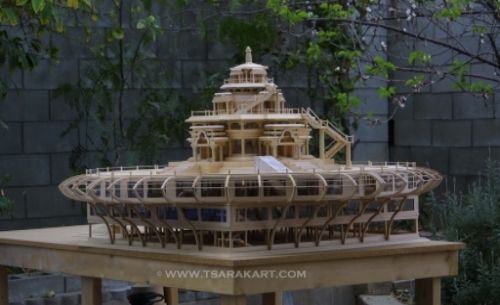
Model of the Shi-tro Mandala Temple in Sikkim, by Pema Namdol Thaye. 2013,
wood. Image courtesy of the artist
Rigzin Dorjee Rimpoche’s hopes for this temple are as high as its spectacular setting. Although Sikkim is primarily a Hindu state, it also has a large Buddhist community, and the temple will provide local Buddhists and Hindus alike with a place for practice. He and others in this small Himalayan village also hope that the temple will attract foreign pilgrims and tourists to Sikkim, a tiny state with a population of just over 600,000. The temple will represent nothing less than a Buddhist paradise, a perfect pure land where enlightened beings reside—a mandala. High in the Himalayas, this mandala temple and the many other mandalas that Thaye has painted and built over the decades will hopefully serve as powerful tools for spreading peace worldwide.
More information about Pema Namdol Thaye’s work can be found on his website: www.tsarakart.com.
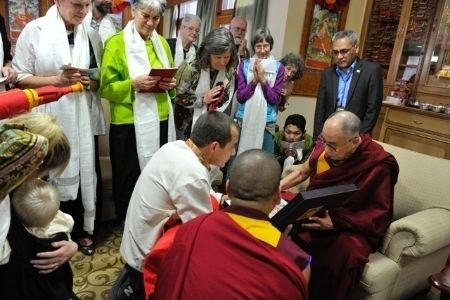
His Holiness the Dalai Lama receiving the first advance copy of
Celestial Portfolio (book number 21 of 108) in Delhi, 2014. Image
courtesy of John Bayes














